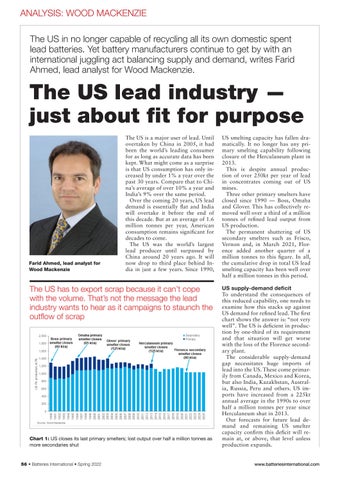ANALYSIS: WOOD MACKENZIE The US in no longer capable of recycling all its own domestic spent lead batteries. Yet battery manufacturers continue to get by with an international juggling act balancing supply and demand, writes Farid Ahmed, lead analyst for Wood Mackenzie.
The US lead industry — just about fit for purpose The US is a major user of lead. Until overtaken by China in 2005, it had been the world’s leading consumer for as long as accurate data has been kept. What might come as a surprise is that US consumption has only increased by under 1% a year over the past 30 years. Compare that to China’s average of over 10% a year and India’s 9% over the same period. Over the coming 20 years, US lead demand is essentially flat and India will overtake it before the end of this decade. But at an average of 1.6 million tonnes per year, American consumption remains significant for decades to come. The US was the world’s largest lead producer until surpassed by China around 20 years ago. It will now drop to third place behind India in just a few years. Since 1990,
US smelting capacity has fallen dramatically. It no longer has any primary smelting capability following closure of the Herculaneum plant in 2013. This is despite annual production of over 250kt per year of lead in concentrates coming out of US mines. Three other primary smelters have closed since 1990 — Boss, Omaha and Glover. This has collectively removed well over a third of a million tonnes of refined lead output from US production. The permanent shuttering of US secondary smelters such as Frisco, Vernon and, in March 2021, Florence added another quarter of a million tonnes to this figure. In all, the cumulative drop in total US lead smelting capacity has been well over half a million tonnes in this period.
The US has to export scrap because it can’t cope with the volume. That’s not the message the lead industry wants to hear as it campaigns to staunch the outflow of scrap
US supply-demand deficit To understand the consequences of this reduced capability, one needs to examine how this stacks up against US demand for refined lead. The first chart shows the answer is: “not very well”. The US is deficient in production by one-third of its requirement and that situation will get worse with the loss of the Florence secondary plant. The considerable supply-demand gap necessitates huge imports of lead into the US. These come primarily from Canada, Mexico and Korea, but also India, Kazakhstan, Australia, Russia, Peru and others. US imports have increased from a 225kt annual average in the 1990s to over half a million tonnes per year since Herculaneum shut in 2013. Our forecasts for future lead demand and remaining US smelter capacity confirm this deficit will remain at, or above, that level unless production expands.
Farid Ahmed, lead analyst for Wood Mackenzie
CHART 1 above (smelter closes) Chart 1: US closes its last primary smelters; lost output over half a million tonnes as more secondaries shut
56 • Batteries International • Spring 2022
www.batteriesinternational.com











